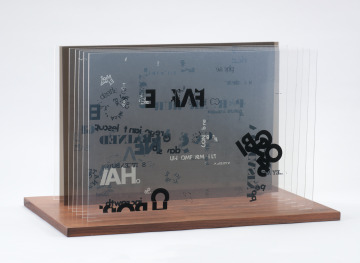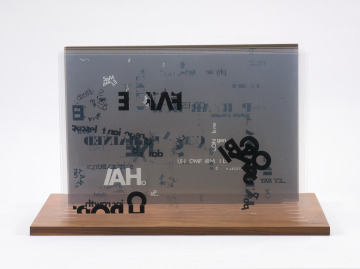Plexigram I, from “Not Wanting to Say Anything about Marcel”
- Publisher
- Eye Editions, Cincinnati, Ohio
- Date
- 1969
- printed in
- New York, New York, United States, North and Central America
- published in
- Cincinnati, Ohio, United States, North and Central America
- Classification
- Prints
- Collection
- Prints, Drawings, and Photographs
- Current Location
- Not on view
- Dimensions
- each panel: 14 x 20 x 1/8 in. (35.6 x 50.8 x 0.3 cm)
base: 24 x 14 1/2 x 3/4 in. (61 x 36.8 x 1.9 cm) - Credit Line
- Gift of Nancy Singer Gallery
- Rights
- © John Cage Trust
- Object Number
- 246:1980a-i
NOTES
The Plexiglas sheets of this object, which was created according to the rules of chance, can be installed in any order. Composer John Cage famously employed chance in his music to remove personal taste and choice. To determine what would be printed on the Plexiglas sheets, he subjected a series of 46 questions to a coin toss, following the I Ching, the Chinese Book of Changes. Cage used diagrams, the questions, and The American Dictionary (1955 edition), to determine all variables, including what word to use and why some of the words are in fragments.
These Plexigrams, as Cage called them, were made while he was composer-in-residence at the University of Cincinnati’s College-Conservatory of Music. Cage’s work was produced to honor the deeply influential French artist Marcel Duchamp, who had recently died. His collaborator Calvin Sumsion was a graphic design student who helped Cage with the text design.
These Plexigrams, as Cage called them, were made while he was composer-in-residence at the University of Cincinnati’s College-Conservatory of Music. Cage’s work was produced to honor the deeply influential French artist Marcel Duchamp, who had recently died. His collaborator Calvin Sumsion was a graphic design student who helped Cage with the text design.
We regularly update records, which may be incomplete. If you have additional information, please contact us at provenance@slam.org.

